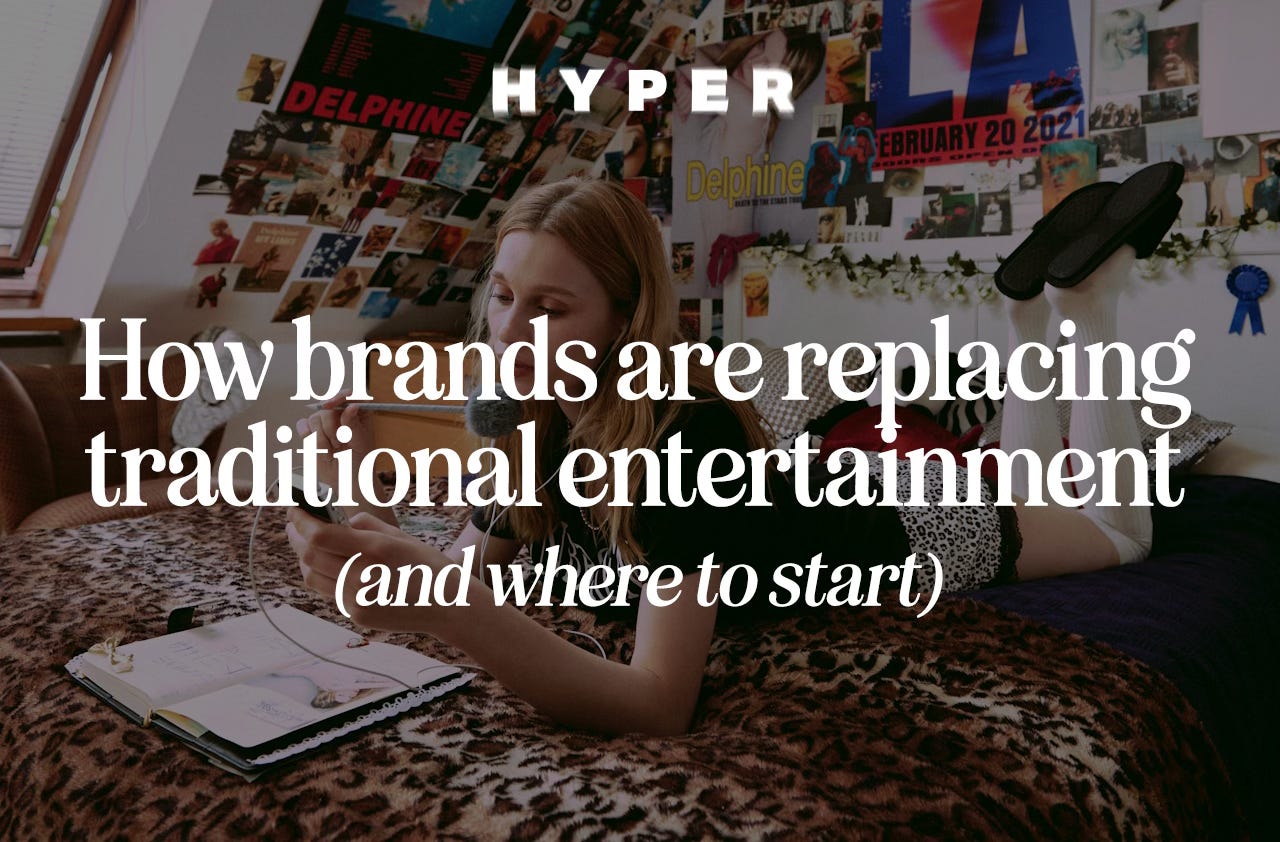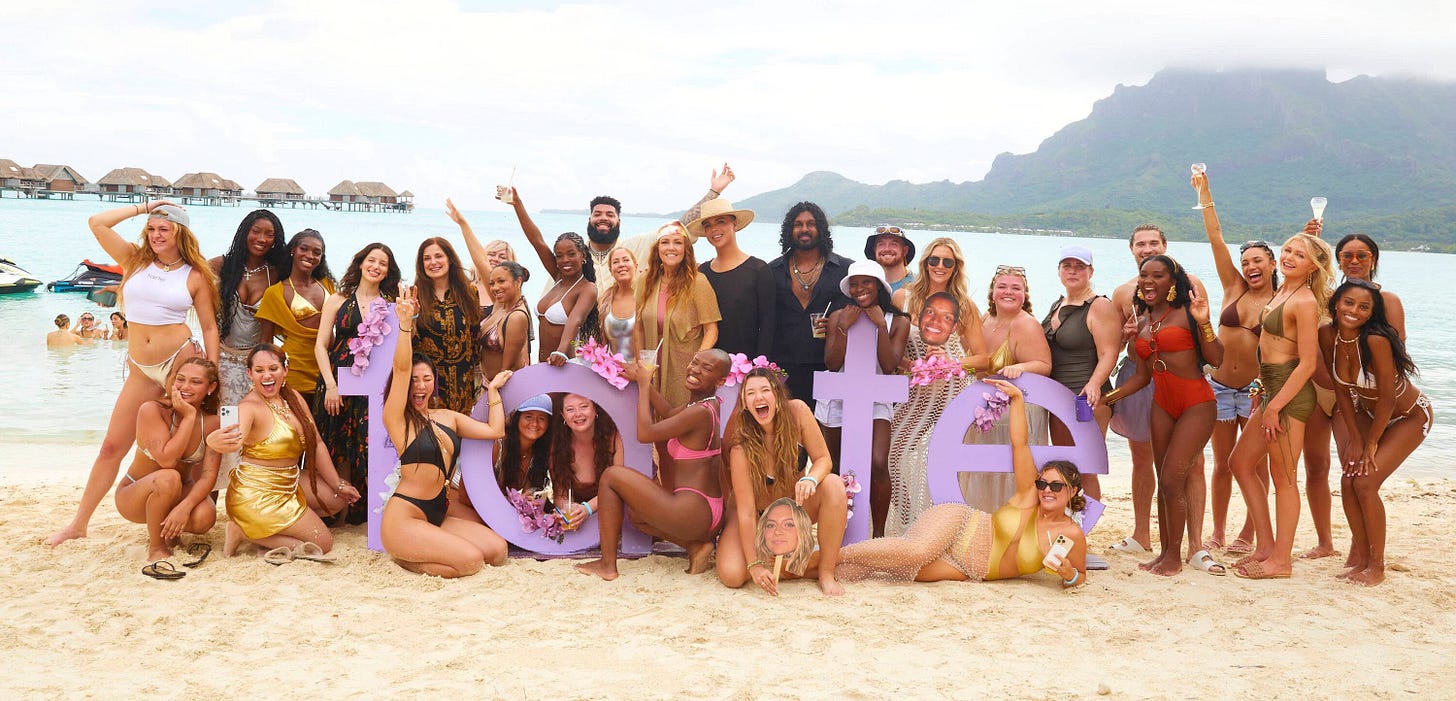Understanding the long game of creative media as a brand tool
+ the transition of traditional luxury to little treats, now to little luxuries
This week Oren is discussing candle marketing and how standing out in saturated markets requires a LOT, while Clayton moves into his new Amsterdam studio.
Oren here - This week we’re going to talk about brands replacing not just TV shows, but TV networks, and the important trends in media consumption that are keeping this opportunity open for future players.
Let’s begin.
It’s often hard for me in meetings, briefs or pitches to explain the size of the shift that the content and marketing world is going through. And with that, the massive size of the prize for any brand or creative.
Perhaps the easiest example is to explain it in terms of traditional television. Entertainment is so fundamentally different it’s very hard for people to fully grasp the repercussions of the shift. Consumption time that was on TV, streaming networks and around shows is replaced generationally by TikTok, Instagram and real streaming (Twitch, not Netflix). Any of the consumption that remains is primarily dual consumption, where that TV programming is consumed while entertainment on the phone is also in play for some or all of the experience.
At the same time, this experience is ultra-fragmented. A link DMed on IG, a link in a WhatsApp group chat, a retargeted ad on a Google Search, a memory of what was brought up in a meeting surfaced in Granola, an anecdote about a campaign on a podcast, TikTok remembering fragments of what you like and showing you related things in a non-linear format more focused on what it thinks you really want than the progression of a story. Millions of snippets that add up to the perception of a person, a trend, a story or a brand.
This changes a number of things. First, any idea that you can control a narrative when the thing people are likely to see first is a response to that narrative from someone out of your brands purview. Then we lose the idea of linear content, that someone will learn something, then gradually progress through a customer or viewer journey.
We’re left with an amorphous media mass that is easier to reach people than ever, and harder than ever to control what they perceive.
Match this up with the “top-of-funnel conundrum” that every creative director, creative strategist and growth marketer deals with with founders, CMOs etc. Everyone wants virality, organic attention, views and engagement to go up and to the right. Then when you detail what the options are for this that work (it’s really just four: influencer-driven world building, episodic content, lifestyle humor, incredible conceptual art direction) they’re immediately worried because it’s so far from the safe branded path. So you repeat, because what works is so far from where the clutching their pearls executive class is comfortable. And then the creatives inevitably just end up somewhere younger, newer, faster, that’s designed to take market share from the companies they're leaving.
So you end up with the only companies taking real shots that connect to be companies that are a. born of social media) or b. desperate. Goli narrowly avoided bankruptcy in 2022, and reinvented itself by going so far and hard in TikTok shop that any traditional consultant or advisor would be shocked. Tarte Cosmetics (one of the core subjects of this email) has been notoriously “okay” to “in trouble” for most of its life, but their massive bet on influence and the future of media has made it a household name for old and new generations.
You’ve heard my concept, echoed by marketers far and wide since I first brought it up, that brands are TV, and their content can reflect that in either episodes or wider narrative. Your employees, influencers are characters, your locations you film in are sets, your announcements, holidays and trade shows are plot. You have enemies and drama, conceptual or real. To act on this concept you have to understand…
Content is no longer linear, it isn’t controlled, if it is a mosaic.
Then, Step 1: Embrace it
You do not want a narrative, you want to be always in the conversation regardless of what the narrative is.
After, Step 2: Conduct it. There is no media that matters, no one cares what anyone on a new age media site writes. Journalist roundups on magazines get less reads than my friends IG carousels. My ‘product versus brand’ series has more views than Wirecutter has page visits. They can’t stop you, they can’t cancel you, nobody cares-but there is still a perception that they dictate or endorse what succeeds. You go directly to the people, and play out your narrative in their court, with zero need to any external validation.
Enter Tarte. Tarte Cosmetics has recreated Bravo online, but controlled by a brand.
They do “influencer trips” called Tarte Island, in seasons. They feature competitions, content on their feed, their staff’s feed, the invited influencer feeds.
There is a massive ecosystem of response content. Who they invited, who got rejected. The efficacy of the concept and its iterations. The actual things that happen on the trip and drama between influencers
This is monetized by the relentless availability of TikTok shop, the views of this ecosystem rival any Bravo franchise, and consumers can buy right there.
Why buy traditional media when you can orchestrate social media to replace it?
Then… Bilt
Bilt is a points and rewards company, that also plays the role of credit card and local tour guide. They position complementary to a bank or credit card, but really you're choosing them versus any typical rewards system. And their marketing how no bank ever would.
Episodic series like Roomies playing TV on social media
Game shows with celebrities on their app and social media
An ecosystem of social-friendly neighborhood events for their (social savvy) customer
And its not just big brands…
Nude Project does their Nude Mansion - a content house with their production, and their friends and family making content. They have a massive podcast that I believe pre-dates the brand, their creative director has a Youtube channel and guests with other big creators, and their social media is skit driven. It’s very focused on the youth, but you can almost look at them as this generation’s Maxim magazine, that also sells graphic tees.
Then Broken Planet.
Perhaps the most interesting and organic of all the above. They sell belonging to kids. They give them a lifestyle they wish they had, a friends they wish they wish they felt cool with, in an ultra-sophisticated organic social strategy no adult brand could ever master.
They have regular creators that phase in and out. Good looking younger people that blow up on social media in tandem with the brand but being brought on trips to Paris and Morocco where they film 90% skits and lip-sync videos to rap music in groups, all wearing Broken Planet. The beautiful, individaul, fitted, cool group of friends their audience wishes that had, and can suddenly recognize that same desire in anyone they see in the gear. A trip with them and their founders might yield 50 TikTok’s across individual and brand accounts, and if you like one you become submersed in the fun, lighthearted web of content the brand never ceases to release.
For the girls, the lads, skits and cinematic, bringing a massive community out.
Steps to start thinking about content this way
Franchise: develop an episodic formats that are repeatable and a core pillar of your content
Ex: The Cheese Store of Beverly Hills
Ex: Big shout out to Cut30’s Binge Snacks who are doing the reality show as a brand.
Spinoffs: strategize spinning these off to other other accounts, are they collabs with guests, do the creators extend this naturally on their social
Customer involvement: contests, trips, or submissions to involve community
Analysis: bring in 1-2 pundits of your industry as mediators, promoters and you’ll see how quickly the others begin to join the conversation
Expand media: How do versions, reposting, interaction spread across all social types, BTS on email etc
Collaborate: Intersect with other brands, series, even trad media
Do consumers want brands to be their source of entertainment? I think they dont actually care, as long as it's relevant to them and they enjoy it. And since they can so easily include favorite online personalities and real people, the affinity potential is higher than traditional media. This is our new world, one where journalism lost trust and relevancy, TV just isn't actually that entertaining, and everything is up for grabs.
Little Treats → Little Luxuries
In this week’s Youtube Oren discusses the new positioning of “luxury brands” to be UX and aesthetic driven versions of common items, with examples and a thorough playbook for how to maximize being able to charge a premium for your brand.
Hyper Reports
Check out our market reports. We spend many hours researching markets, categories, and brands & products within the consumer space so you don’t have to.








I think the problem is, there's no brand that has employed this strategy that isn't also corny. Nude Projects is a pretty garbage clothing brand, and so is Broken Planet. They aren't taken seriously in fashion spaces. As of yet, I have not seen a brand actually execute these types of marketing strategies in an interesting way that preserves 'cool'.
interesting read. lot to think about